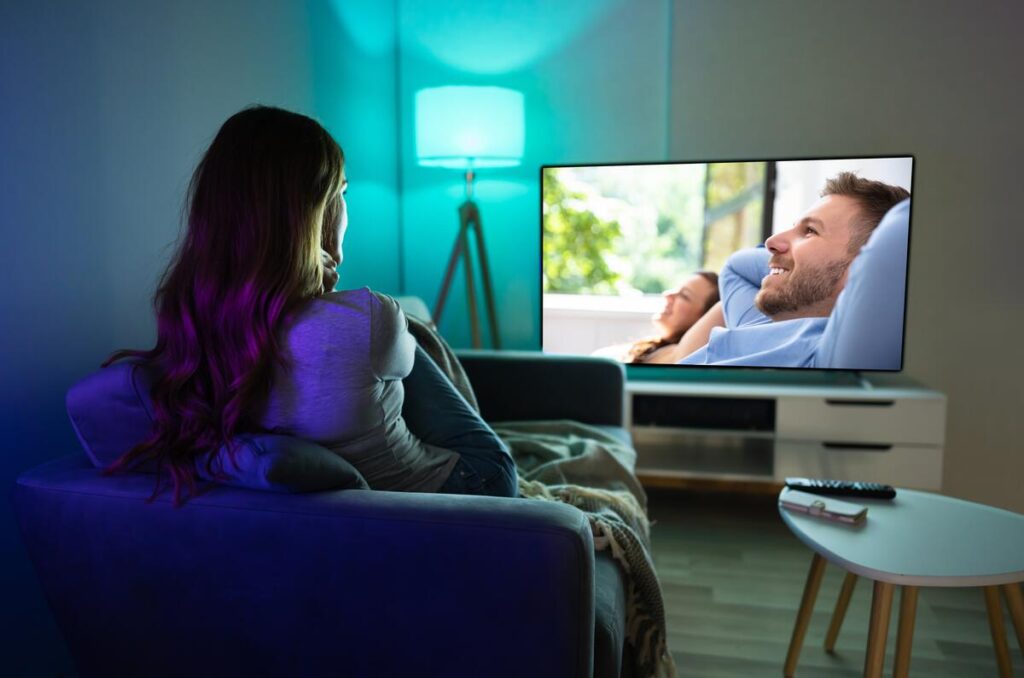Are OLED TVs Better For Glare (Read This First!)
Disclosure: Tech Parasol is supported by its readers. When you purchase through links on our site, we may earn an affiliate commission. Thank you.
- OLED TVs are NOT better for glare.
- QLED TVs are the best for glare and brightly lit environments.
- LED TVs get much brighter than OLED TVs and therefore do a better job of warding off unwanted reflections.
Glare is really annoying and can be hard to get rid of, depending on the environment a TV is in of course.
But the type of TV you have can make a real difference to the amount of reflections you’re likely to see.
So when it comes to glare, which type of TV handles it the best, OLED or LED?
Here’s what you need to know about OLEDs and glare:
Modern LED TVs handle reflections better than OLED TVs and are therefore better suited to brighter environments. LED TVs can get much brighter than OLED TVs and are therefore more likely to ward off reflections. That being said, all TVs produce some amount of glare.
If you’re really concerned about glare, an LED TV will show less reflections than an OLED TV. QLED TVs handle reflections better still as they can get extremely bright.
But if you’re able to place an OLED TV in a darker environment, you’ll benefit from a better picture overall.
Before we get into why OLEDs are worse for glare, let’s take a moment to understand what glare actually is.

What is glare?
Glare happens when any light source hits the TV screen and reflects off it and into your eyes along with the light from the picture itself.
Glare caused by reflection from the sun or a nearby window can be especially annoying.
It can also be hard to ignore especially if all you can see is a reflection of the various objects in your room.
This can, at worst, prevent you from seeing what is actually on screen and you could miss a crucial part of a movie or TV program.
Glare can also make it look like the picture quality is worse than what it actually is.
Unfortunately, all TVs have some sort of glare because modern TVs have a glossy finish to them, which effectively turns the TV into a mirror.
Now that we know what glare is, let’s look at why OLEDs are worse for glare.
Why are OLED TVs worse for glare?
The main reason why OLED TVs are worse for reflections is that they don’t get as bright as LED TVs.
The reason they don’t get as bright is that OLED TVs don’t have a powerful external LED backlight to light up the pixels on the display.
Instead, they have individual Organic Light Emitting Diodes (OLEDs) that light up when a voltage is applied to them.
These OLEDs are much smaller, less powerful and don’t produce as much light as the large LEDs that make up an LED TV backlight.
OLED TVs also have the ability to completely switch off each individual OLED, producing true blacks.
This ability to completely switch off individual OLEDs enables much better contrast ratios and a better quality picture overall.
But completely black areas of the screen will reflect more light and cause more annoying reflections.
Do OLED TVs have anti-glare?
OLED TVs do have anti-glare coatings applied to them and LG is the first company to receive a “discomfort glare-free” certification for their OLED displays.
The anti-glare coatings that are applied to OLED TVs can reduce the intensity of the reflections.
But glare can’t be eliminated completely.
Are QLED TVs better than OLED TVs for anti-glare?
QLED TVs outperform OLED TVs in terms of anti-glare because they are much brighter than most standard LED and OLED TVs.
QLED TVs are LED/LCD TVs at their heart and so have an external backlight.
But they also have a layer of Quantum Dots between the LED backlight and LCD layer.
This layer not only increases the overall brightness of the TV, but it also improves the colors that the TV produces.
Are OLED or LED TVs better for bright rooms?
Hands down, LED TVs are much better for bright rooms.
But that doesn’t mean that you can’t watch an OLED in a bright room.
If you’re watching a brightly lit scene, then you’re not going to notice the reflections as much.
But in very dark scenes, the TV will appear very mirror-like, especially if you have a direct light source such as a lamp or window shining directly at the TV.
So you do need to consider the environment for your new TV.
OLED TVs are better suited to dark or dimly lit rooms, where light sources aren’t directly shining at the TV.
And because the pixels on an OLED TV can be completely turned off, you won’t see any blooming around bright objects.
Nor will you witness any backlight bleed, which you may notice with an LED TV.
Check out the video below which compares the two TV types in different environment perfectly:
Tips to reduce glare
As annoying as glare is, there are some things you can do to help reduce its effects. Here are my top tips:
Turn off the lights
Avoid lamps that point directly at the TV and avoid overhead lights, like ceiling spotlights.
By turning off the lights or closing the blinds, you can reduce reflections and get the best picture possible from the TV.
Positioning lamps behind a TV is a great way to reduce reflections and light up the room at the same time.
Position the TV correctly
Be sure to position your TV away from windows and away from objects that the sunlight may hit.
Prolonged exposure of a TV to direct sunlight can also cause damage to the pixels.
Adjust the angle of the TV
If your TV is on a stand, adjusting the angle will help to divert the reflections elsewhere so you can’t see them.
Some wall mounts allow you to do this too.
Just bear in mind that the picture on an LED TV won’t look as good at an angle.
OLEDs on the other hand look great from all viewing angles.
Increase the TV brightness
Turning up the brightness can help reduce glare.
The downside to this is that it can saturate the picture, affect the contrast ratio and shorten the lifespan of the LEDs.
But in general, the more light a TV can produce, the less likely you will see reflections, because you are effectively fighting light with light.
But many TVs already operate at full brightness when watching HDR content.
Some TVs, like LG OLEDs also have ambient light sensors built into them which automatically adjust the brightness of the screen according to the ambient lighting of the room.
Get an anti-glare screen protector
If you’ve tried all the above and you’re still getting glare, then you can try an anti-glare screen protector.
These devices attach directly to the screen and can be used to reduce glare and help protect against damage to the screen.
Sources
New LG OLED TVs are ‘glare free’ – but does it matter?
Get rid of annoying TV glare with these 5 tricks – CNET

Robert Anderson
Robert Anderson, the founder of Tech Parasol, had a keen interest in tech from a very young age. He studied Electronic Engineering at University and then went on to become a Software Developer. He launched Tech Parasol in 2021 to share his knowledge with the aim of making tech easier to understand for everyone.

